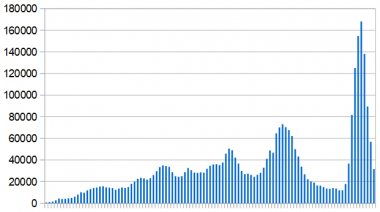The cockpit voice recorder of the Russian airliner that crashed in Sinai is unlikely to settle the question of what caused the disaster that killed 224 people.
According to Ayman al-Muqaddam, the chief Egyptian investigator, a "noise" can be heard in the final second of the recording. Muqaddam hasn't elaborated about the sound, but says "spectral analysis will be carried out by specialised labs in order to identify the nature of this noise".
In a similar vein, the Russian Interfax news agency said the recording ends with "sounds uncharacteristic of routine flight".
Meanwhile, an anonymous sources inside the investigation told the France 2 TV channel the sound heard at the end of the recording is that of an explosion. Over-excited journalists then interpreted this as confirmation of a bomb.
Nobody seriously doubts that there was an explosion on board the crashed Airbus. The question is whether it was caused by a bomb or explosive decompression resulting from previous damage to the aircraft. However, laboratory analysis of the sound recording is unlikely to provide a clear answer.
In an academic paper published in 2003, Stuart Dyne, of the Institute of Sound and Vibration Research at Southampton
University, wrote:
"Rapid identification of the cause of failure is a high priority in the immediate aftermath of a major civil aircraft accident. Attention is often focused on the two recorders, the Cockpit Voice Recorder (CVR) and flight data recorder. In the event of sudden, catastrophic loss of an aircraft through explosions or structural failure decompressions, the recordings are seen as even more important.
"Yet these recorders are not designed to record such events with great fidelity and the ability of accident investigators to interpret such recordings has been severely tested in several major accidents in the past thirty years; comparisons between accident recordings have not been able to produce conclusive results."
Dyne's paper discusses recordings of explosions and rapid decompressions on a variety of aircraft from trials in several countries. It goes on to argue that CVR recordings are "generally unable to discriminate between explosions and structural failure decompressions" and explains why.
A blog post on the Runway Girl Network makes a similar point, quoting Mike Poole, an expert on flight recorders and CEO of Plane Sciences. Poole says:
"When you have a plane blow up at altitude, an explosion regardless of the source, a bomb or a fuel tank or structural failure with explosive decompression, the noise you hear is noise. There is no structure to the sound and the bandwidth isn’t there to provide that kind of data."
Posted by Brian Whitaker
Wednesday, 11 November 2015

 RSS Feed
RSS Feed

